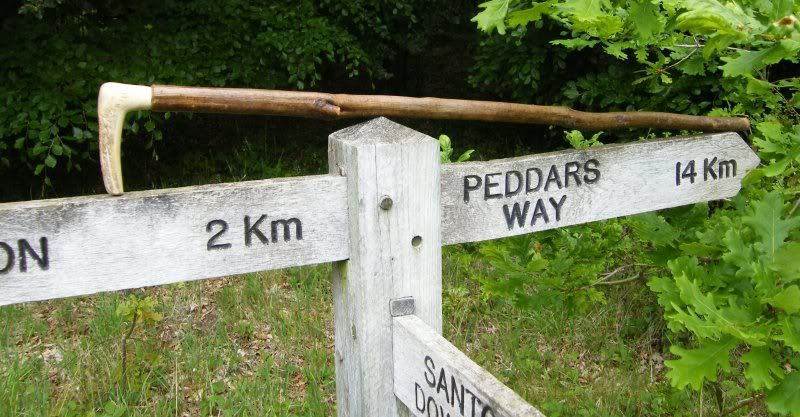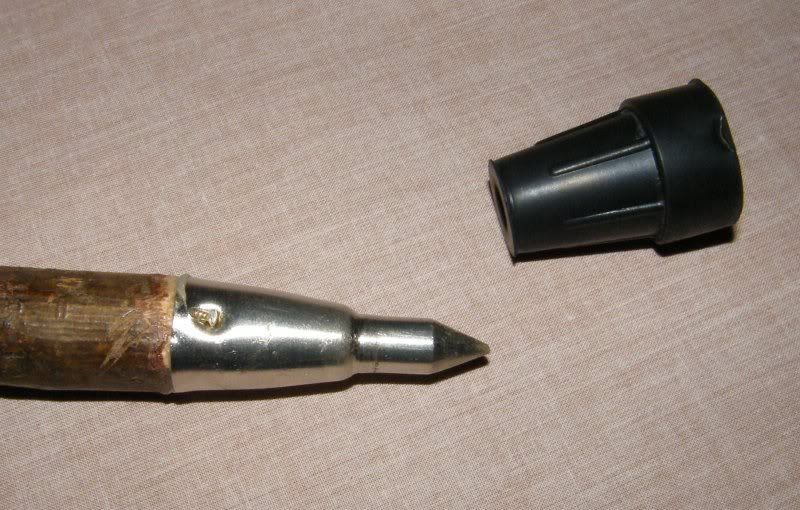|
-
I make my own. The authoritative book on the subject is Stickmaking Handbook, by Andrew Jones and Clive George. They explain how to make one with a wooden crook that won't break. Those made with sawn crooks are inherently weak -- thinking of ring porous hardwoods, although elm doesn't like to break so much. Also checkout Walking Sticks by Edward Hart and Walking and Working Sticks by Theo Fossel.
When walking through the woods, use you imagination, learn to look at the way the trees and bushes grow. Walking sticks tend to grow upside done, with the best part for the top of the stick being low, and the main portion of the stick growing upward. Your material needn't be perfectly straight. Gentle curves in a stick can be straightened. Sharp bends have to be worked around. Many woods can easily be curved into a full crook.
Here is another place to by shepherds crooks.
http://www.walking-canes.net/hickory...dsstaff59.aspx
I haven't looked today, but a few nights ago I did a search to see if hazel wood crooks might be available, and sure enough found several places. My hazel stick got chewed up by the dog. Hickory is heavy. Hazel fairly light in comparison.
A different kind of shepherds stick is called a cleek. You might search using that word.
Almost forgot this one: http://www.highlandhorn.com/
Last edited by Benning Boy; 26th May 14 at 12:14 PM.
-
-
 Originally Posted by Benning Boy

When walking through the woods, use you imagination, learn to look at the way the trees and bushes grow. Walking sticks tend to grow upside done, with the best part for the top of the stick being low, and the main portion of the stick growing upward. Your material needn't be perfectly straight.
I'm always on the lookout for a good stick.  Once the candidate is harvested I leave it outside, bark on, for six months to a year. Once I think it's ready I shave the bark and generally smooth it up. A couple of weeks after it gets two coats of flat polyurethane and it's done. Once the candidate is harvested I leave it outside, bark on, for six months to a year. Once I think it's ready I shave the bark and generally smooth it up. A couple of weeks after it gets two coats of flat polyurethane and it's done.
In the picture: The one on the left is maple. It’s 42” and weighs 13 oz. It's been with me seven or eight years. Browsing around here it became apparent that a "staff" was a basic kilt accoutrement. I knew I didn't want a hook/crook so I fashioned the one on the right out of elm. Its 52” and weighs 19 oz.

Tulach Ard
-
-
 Originally Posted by Benning Boy

Also checkout Walking Sticks by Edward Hart and Walking and Working Sticks by Theo Fossel.
Way back in the mid-70s, I once took a four day Stick-Making course taught by Theo Fossel (paid for by the RAF). One of the most interesting and informed individuals that it has been my privilege to meet. This is the stick I produced at the end of the four days.

It was such a constant companion that five years ago, I had to attach a ferrule and spike, to make up for the 1 1/2" that had worn away!

-
-
Interesting that cromach isn't in my Gaelic dictionary. (I love linguistic stuff.)
What there is is:
crom, v. bend, stoop, decline; descend, bow
crom, n. m. a circle; ridge
cromachas, n. f. bandy-leg
cromadh, n. m. roof; act of bending, stooping, bowing; a measure of length equal to the full length of the middle finger
cromag, n. f. anything bent; a peg or catch, a tache, a hook to hang on, a fish-hook
cromaichean, n. pl. the aged
Based on this alone, I would guess that the Gaelic might be cromag (a bent thing). It is sort of like a big fish-hook after all.
A very large number of vintage photos show what appears to be an ordinary cane

This is the only early photo I have showing a taller cane, though not very cromach-like

A couple seen in The Highlanders of Scotland (one at a very oblique angle)

A later photo showing quite a few

Here's a mix of canes and cromaich (pl ?) (cromaig?)

And nowadays

The Renaissance Faire around here always has at least one walking stick maker with a large variety of things, some of them rather Scottish-looking.
Last edited by OC Richard; 27th May 14 at 04:17 AM.
Proud Mountaineer from the Highlands of West Virginia; son of the Revolution and Civil War; first Europeans on the Guyandotte
-
The Following 2 Users say 'Aye' to OC Richard For This Useful Post:
-
Richard, I believe cromack or cromach is the Scottish English word which derives etymologically form the Gaelic cromag. A 'g' at the end of a word is pronounced like a 'k' so cromag is pronounced cromack.
I'm still looking for the quintessential ram's horn cromach, but I haven't found a source for the raw horns. I am a bit of an amateur stick maker though and used some antler generously provided by Crash to fashion a few sticks.

Here I am using one of them in the wild.


I found this wooden one in a local kilt shop and it was the only one they had. It has served me well so far.

I found this short walking stick/cane at a thrift shop for $5 but it has a distinctly cromach-like head on it and I'm fond of it. Sadly, it is a tad short for me, even as a cane. I might add a spike to it, so it will be up to a comfortable size.


McMurdo's gorgeous cromach (cromag) is in the U.S.A. at the moment, so he borrowed my short walking stick last weekend and I think it still works nicely with Highland attire. There is a precedent for this style as OCRichard's old pics demonstrate.

Last edited by Nathan; 27th May 14 at 05:19 AM.
Natan Easbaig Mac Dhòmhnaill, FSA Scot
Past High Commissioner, Clan Donald Canada
“Yet still the blood is strong, the heart is Highland, And we, in dreams, behold the Hebrides.” - The Canadian Boat Song.
-
The Following 3 Users say 'Aye' to Nathan For This Useful Post:
 Posting Permissions
Posting Permissions
- You may not post new threads
- You may not post replies
- You may not post attachments
- You may not edit your posts
-
Forum Rules
|
|

























Bookmarks